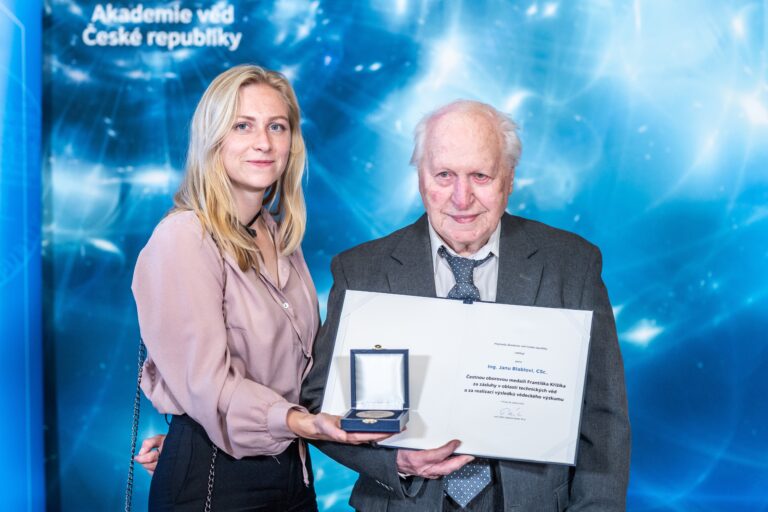Ing. Jan Blabla, CSc., who has been connected with our Institute since its very foundation – he joined us on 1 October 1954, the very first day of the institute’s operation – was awarded the František Křižík medal for his contributions to technical sciences and for translating research outcomes into real-world applications.
Jan Blabla became renowned above all for his pioneering work in the practical use of lasers, a story also captured in the documentary The First Laser Eye Surgery in Czechoslovakia and in several articles published in JMO – Precision Mechanics and Optics Journal marking the 60th and 70th anniversaries of our Institute.
The ceremonial event took place on 6 October in the representative premises of the Czech Academy of Sciences at Villa Lanna in Bubeneč. The laudatio was delivered by Assoc. Prof. Pavel Peterka, Ph.D., Director of the Institute.
“Ladies and gentlemen, I first met Jan Blabla shortly after the Velvet Revolution, when he gave a talk about his professional journey with lasers in one of the lecture halls of a university in Dejvice. Imagine a large hall: in the middle stands Jan Blabla, beside a glass tube from one of his helium-neon lasers. The windows were darkened, and when the lights went out, the entire hall plunged into darkness. Suddenly, the tube lit up and a red laser beam cut sharply through the space. Jan Blabla is an extraordinary storyteller. At that time, I was deciding which field to specialize in after two years of studying at the Faculty of Nuclear Sciences and Physical Engineering (FJFI), and he convinced me that lasers were not just theoretical constructs - they were tangible, meaningful, and practical. That scene in Dejvice was probably much like the first public demonstration of a laser in Czechoslovakia, which Blabla performed in the spring of 1963 at the Planetarium in Stromovka. And that was only one of several national firsts achieved by Blabla and his colleagues: in 1963, they organized the first university course in laser physics, held jointly by the Academy of Sciences and the Czech Technical University (ČVUT) right here in our institute’s building. The over 700-page lecture notes became the first comprehensive Czech publication on lasers. In June 1964, using Blabla’s laser, the first Czechoslovak laser eye surgery was performed - a major reason why we proposed Jan Blabla for the František Křižík medal. Looking back today, it’s an incredible story: less than two years after constructing the first functional laser device - built mostly from Czechoslovak components - the first laser surgery on a retina took place directly in his laboratory. The operating physician showed remarkable courage, but the risk paid off: the surgery was successful, inspiring the production of laser ophthalmic coagulators used in hospitals to successfully treat thousands of patients. The normalization purges of the 1970s marked the end of Blabla’s work at our institute, but not his work with lasers. Fortunately, he found a position at the Czech Metrology Institute, where he continued to develop laser length metrology. He remained in close collaboration with the Academy, especially with the Institute of Scientific Instruments (ÚPT) in Brno. Jan Blabla had been with our Institute since day one, from 1 October 1954, working initially in the precision time team. Today, our current collaboration with ÚPT focuses on time transfer and optical clocks, bringing his story full circle. Finally, I cannot fail to mention Jan Blabla’s love of music - he played the organ, led the choir at St. Ignatius Church on Karlovo náměstí, and founded the Spectrum Publishing House, which produced sheet music. I hope that the Academy of Sciences will continue to have many researchers who, like František Křižík and Jan Blabla, are able to translate scientific results into tangible benefits for people.”
Pavel Peterka, Director of the Institute of Photonics and Electronics (ÚFE) Tweet
Photo: Jana Plavec, Czech Academy of Sciences

